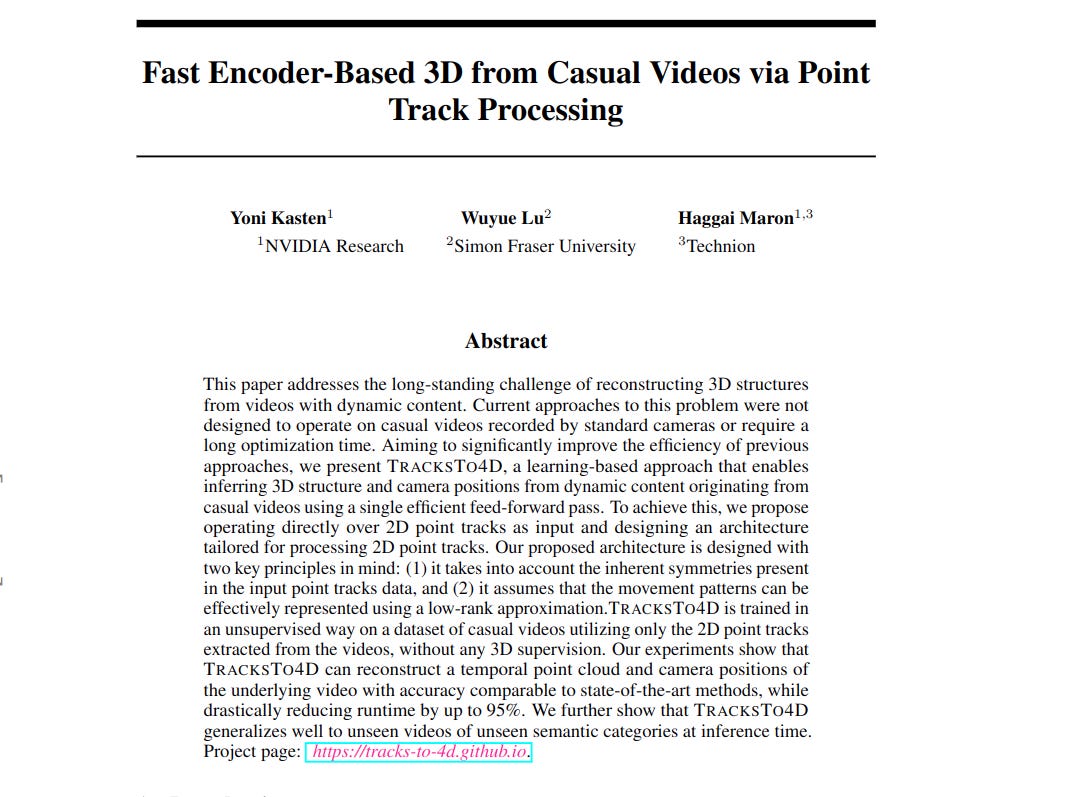"Fast Encoder-Based 3D from Casual Videos via Point Track Processing"
Below podcast on this paper is generated with Google's Illuminate.
https://arxiv.org/abs/2404.07097
The paper addresses the challenge of efficiently reconstructing 3D structures from casual dynamic videos, a problem where existing methods are slow or not applicable to standard videos. This paper introduces a fast, learning-based approach to infer 3D structure and camera positions from these videos through a single feed-forward pass.
The paper proposes a method that processes 2D point tracks as input and uses a tailored neural network architecture to achieve efficient and accurate 3D reconstruction.
-----
📌 This paper smartly shifts from raw pixels to point tracks. This input abstraction enables the model to learn motion patterns, not just scene specifics, boosting generalization to new videos.
📌 The architecture ingeniously incorporates symmetries via attention. Temporal and point permutation equivariance is enforced, making the network inherently geometrically aware and efficient.
📌 Low-rank motion constraint is key. By predicting a basis and coefficients, the model simplifies dynamic scene representation, making unsupervised 3D learning from 2D tracks feasible.
----------
Methods Explored in this Paper 🔧:
→ The paper introduces \ourmethod, a learning-based approach for fast 3D reconstruction from casual videos.
→ \ourmethod\ takes 2D point tracks extracted from videos as input, instead of raw images. This design choice aims to improve generalization across different video types.
→ A novel neural network architecture is designed, considering the symmetries of point track data.
→ The architecture incorporates permutation symmetry across tracked points and time-translation symmetry across video frames.
→ The network uses transformer layers with self-attention mechanisms, alternating attention between the time and track dimensions.
→ To address the ill-posed nature of 3D reconstruction from 2D, a low-rank movement assumption is integrated.
→ The network predicts a set of basis point clouds, and the dynamic 3D structure is represented as a linear combination of these bases.
→ The first basis is modeled as a static approximation to aid camera pose estimation.
→ The method is trained in an unsupervised manner using reprojection error as the primary loss function.
-----
Key Insights 💡:
→ Point tracks are more effective input representations than raw pixels for learning generalizable motion patterns from casual videos.
→ Incorporating symmetry considerations into the network architecture improves performance and respects the inherent structure of point track data.
→ Enforcing a low-rank structure on the predicted 3D motion regularizes the solution and makes the ill-posed problem more tractable.
→ Using a static basis approximation and motion level values helps in disentangling camera motion and dynamic object motion.
-----
Results 📊:
→ \ourmethod\ achieves up to 95% runtime reduction compared to state-of-the-art methods.
→ It demonstrates comparable 3D reconstruction accuracy to existing methods on pet videos.
→ On pet videos, it achieves depth Absolute Relative difference of 0.11 for dynamic points and 0.08 for all points.
→ The method generalizes well to out-of-domain videos with different object categories, maintaining competitive performance.
→ On out-of-domain videos, it achieves depth Absolute Relative difference of 0.05 for dynamic points and 0.03 for all points after fine-tuning.


